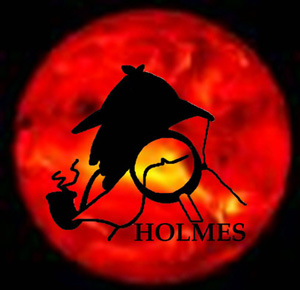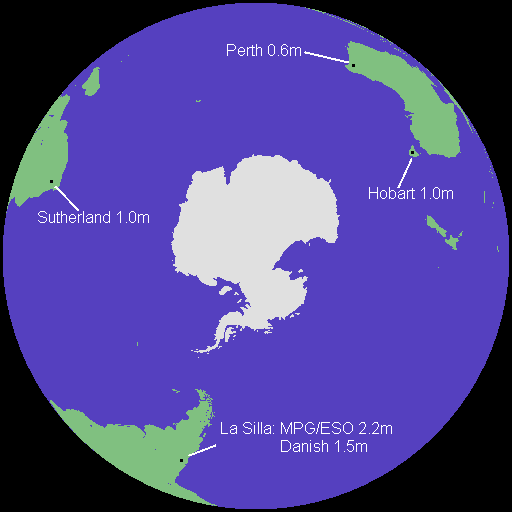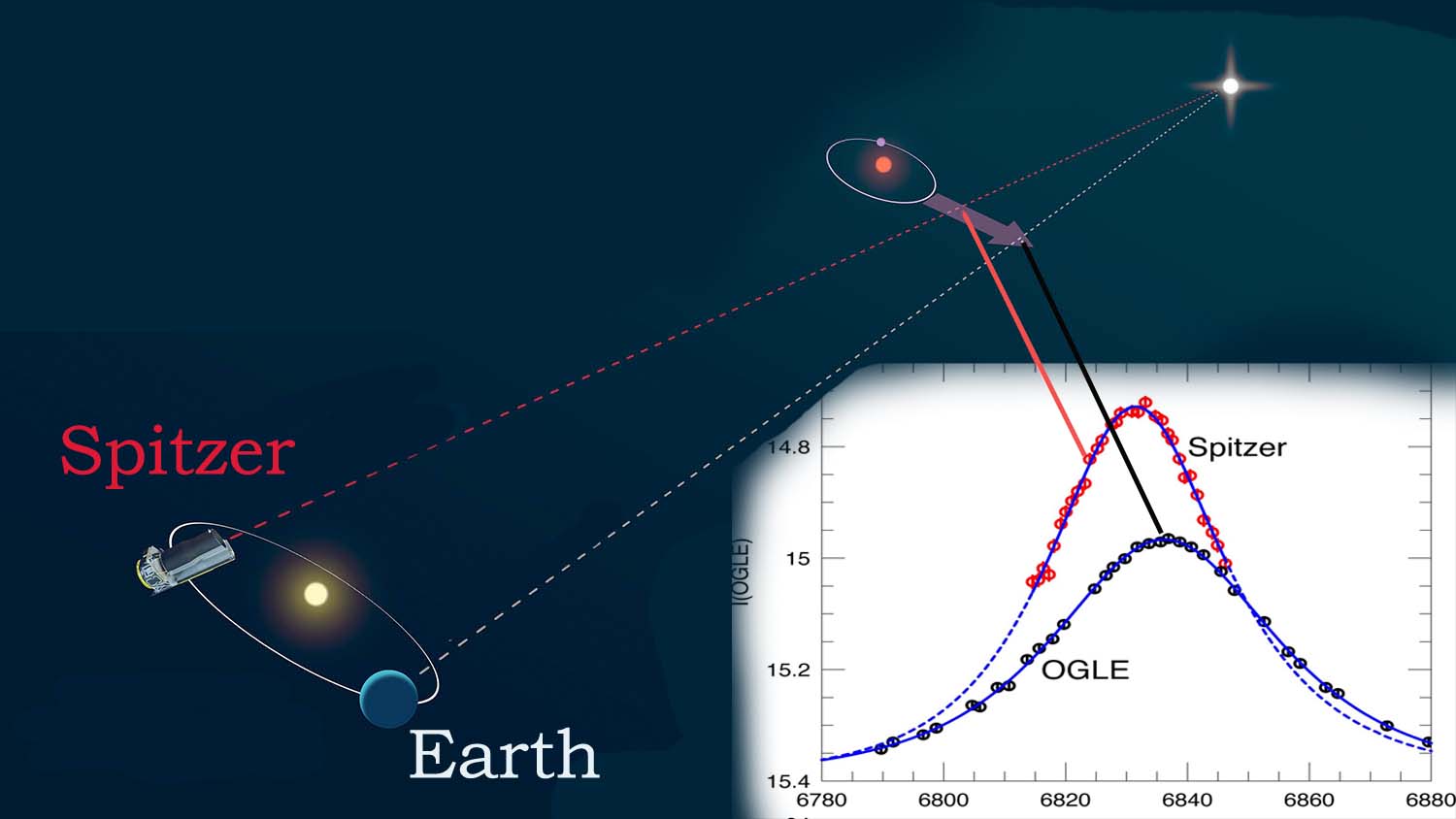|
PLANET collaboration
Since 1995, PLANET is an international collaboration searching for extrasolar planets via microlensing effects. We are work closely with the OGLE, MOA, LCOGT and KMTNet teams forming a global Worldwide consortium, sharing our resources, observations and models real time. |
|
2015 season
We have a new 1.3m telescope, the University of Tasmania Greenhill Observatory on the Bisdee Tier hill. After arriving to Hobart in November 2012, the new telescope has been assembled at UTAS, then moved to the new observatory . There has been a lot of work
by our Tasmanian friends (with some help of the Frenchs) on the telescope to make it operational.
The observatory is nammed after our friend and colleague, Professor John Greenhill who left us last year.
Obituary at University of Tasmania .
Talk by JP Beaulieu in Memory of John Greenhill at the 19th microlensing conference in Annapolis in January 2015 .
Our friend and colleague is dearly missed. Getting first exciting results is a way for our group to praise his legacy.
The telescope has produced his first exciting follow up of a microlensing light curves in May 2015. Andrew Cole (UTAS) and Jean-Baptiste Marquette (IAP) have monitored the peak of the very high magnification event (Amax=1100) OGLE 2015-BLG 1395/MOA 2015-BLG-284. It has very high sensitivity to exoplanets. Small deviations from point source point lens, and finite source point lens models have been detected at the peak and are under investigation. The telescope is on alert mode while being commissionned and tested.
On June 29 it will try to observe a Pluto occultation. It is an excellent opportunity to probe Pluto's atmosphere just before the arrival of the New Horizon spacecraft.
Moreover, there is a long tradition of Pluto occultation observation in Tasmania since it was the done for the first light of the
Canopus telescope when it came online more than 35 years ago.
We will continue to distribute real time photometric data for microlensing events(when available). We are collaborating intensely with Cheongho Han and his group (KMTNeT). We are using his binary lens models on the real time data pages. There is a very interesting new route to measure masses of individual microlensing events by observing them simultaneously from the ground and a from a distant satellite, such as Spitzer or K2. In 2015, the Spitzer telescope is doing 830 hours of pointed observations of selected on going microlensing events. Flat fielded, dark subtracted dithered frames are made by available by the Spitzer Science Center (courtesy Sean Carey et al.). We have adapted the PLANET image subtraction pipeline to Spitzer images. We are providing here photometric light curves obtained with Spitzer and the IRAC camera at 3.6 microns. The data provided with the standard format used by PLANET (ASCII files). These data have to be combined with the ground based photometric data used to trigger the observations from both the OGLE, MOA, KMTNet, LCOGT teams. On the plots, single lens models are updated real time by us, while binary lens models are provided by Han's group. On the page you will find a summary of the 2015 microlensing events. Spitzer data,when available, are plotted in pink, and are labelled "S". All the figures have been prepared the same way and are updated automatically. We fit a point source point lens model to all the ground based data. We then overplot the Spitzer photometric light curve. It is informative, because we can see the data quality that has been obtained. It is possible to see also how the microlensing is evolving as seen from space compared to the ground. For instance, is the peak seen before or after from space compared to the ground. A full fit taking into account ground-space parallax is not yet implemented in the "PLANET plotter", but it will be of course be performed for the publications to come. Photometry produced by (JC Morales, JP Beaulieu, C. Coutures) For the 2015 planet hunting season, we are showing the List of monitored events (with online data files, including data from Spitzer).a l O h a is a fast utility to have a glimpse on OGLE data to pin down anomalous events and switch rapidly to intense observing. (contact us to have username and passwd, we cannot have it fully openned to the public for security issues). It is very useful to select high magnification events, free floating planet candidates, anomalous events. (developped by Jadzia Donatowicz & Etienne Bachelet for the modeling light curve side) |
|
ONLINE DATA |
TOOLS & MODELING
Watch List of possible High Magnification events Latest modelling of ongoing events by Cheongho Han and students. This is password protected: Contact us. |
|
Telescopes doing microlensing follow up. Site identification. (Example: in 2015 S=Spitzer)
|
|
PLANET 1995-2013 PUBLIC LIGHTCURVES
|
|
PLANET 1995-2014 last eventlists
(restricted access )
|
|
HAN CHEONGHO MODELS 2008-2015
|
Our Collaborator's
information and useful tools can be found at:
Updated 2015-12-31 Ch.C
OGLE
Survey group in Chile. They are currently upgrading thier telescope. A list of pre 2009
events
MOA
Survey group in New Zealand. A list of thier current microlensing
alerts
μFUN
Follow up group of Ohio State Uni, and amateur astronomers world wide. A quick-look photometry
archive
RoboNet II
Automatic follow up telescope network with customizable priority list for microlensing
targets
and associated page that provides a telescope specific prioritized list.
PLOP
MiNDSTEp
and ARTEMIS consists of an automatic data collection, modelling and alert detection system.
It has similar layout/methedology/functionality as the PLANET pages (above)
but there are differences in the implementation of models.
There is a sorted prioritized list
and an interactive plotter

At IAP, PLANET is funded by
HOLMES collaboration (J.P. Beaulieu, Pascal Fouqué)

Planet has found the first earth-like exoplanet Information available.
